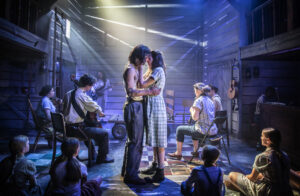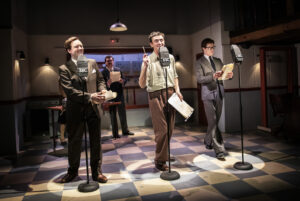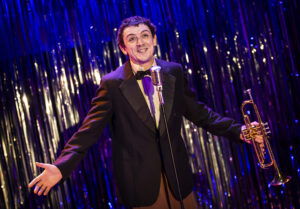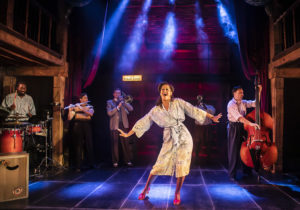Do dance and a dead mother improve Lloyd Webber’s ‘problem’ musical?
★★★

This energetic production of Whistle Down The Wind at The Watermill Theatre offers a radical re-interpretation of Andrew Lloyd Webber’s problem musical. I say ‘problem’ because it’s never quite been the hit many of us thought it would be. The musical was launched in the USA back in 1998. I think it has one of Lloyd Webber’s better scores, the country rock style being preferable to his attempts at being a modern day Puccini.
You might think a clash of beliefs would be just right as a story for our times. In this case, the conflict is between children who believe an escaped prisoner (called The Man in the cast list) is Jesus and adults who think he is the devil incarnate. Yet, despite this, and Jim Steinman’s gothic lyrics, Whistle Down The Wind never made it to Broadway.
I suspect the fundamental flaw is that the leader of the children, Swallow, is not a child, as she was in the earlier book and film. Instead, she is portrayed as an adolescent and, really, too old to be so credulous. Maybe the decision was made so that an adult lead could be cast, maybe the authors thought it would be more interesting to include some sexual content. Whatever the reason, the wind never got into the musical’s sails.
Now Tom Jackson Greaves has been given a chance to resurrect this musical about a man mistaken for Jesus, and he has some radical ideas about how to make it work. So does his new interpretation solve the problem? I’m afraid not.
The show begins well. The set, a terrific design by Simon Kenny, is the interior of a building constructed of wide wooden planks, which merges with the auditorium and doubles as the church and the barn. The Watermill Theatre is an intimate space, so, from the start, it is as if we are part of the congregation and of the children’s conspiracy. And we feel the claustrophobia of this closed, deeply religious community, back in 1950s Louisiana. It’s a community that is wary of strangers and over protective of its children.
A spirited interpretation
So far so good, but, as I said, this is a major new interpretation. Tom Jackson Greaves has a long list of credits as a choreographer and, as director, he introduces a considerable amount of dance and stylised movement. This works well to enhance the emotional story and ratchets up the fraught atmosphere, as, for example, when the two sides circle to form impressive physical barriers against each other. And the clever use of dance as a metaphor enables The Man to move among them, right into the centre of scenes in which he would normally be hidden. This is done most notably in the powerful song Wrestle With The Devil in which the townspeople imagine The Man as The Devil.
The biggest change concerns Swallow’s dead mother. In previous productions, she has been an unseen presence, a catalyst in alienating Swallow from her father and therefore giving her greater motivation for wanting a parent figure in her life. In this production, her mother is an actual presence, watching over her shoulder and dancing with her. It brings grief to the forefront and therefore changes the balance of the musical, and indeed the balance of her mind. Grief seems to guide her every thought and deed. It may be an attempt to explain her irrational behaviour but there is, in my view, nothing in the script to justify this interpretation. In the end, it confuses rather than clarifies.
The Mother- beautifully danced by Stephanie Elstob– mostly gets in the way. In the A Kiss Is A Terrible Thing To Waste scene where Amos wants to kiss Swallow and The Man watches and comments, the Mother gets involved too and the tense musical trio becomes a muddled dance quartet. The stage is small enough as it is without squeezing a supernumerary.
Grief or Belief?
Much more than grief, Whistle Down The Wind is a musical about belief, particularly extreme beliefs. Its most well known song, the bland No Matter What, is an anthem for anti-vaxxers and climate change deniers. ‘What you believe is true’ is the essence of a divided society in which the two sides will not listen to a different point of view or accept evidence or be prepared to compromise. The children believe The Man is Jesus, the adults believe he is the Devil.
The musical is also about belief in people. We see that it can help redeem an individual, as in the moving scene between The Man and Swallow in which he sings Nature Of The Beast and realises that his life could have been different if someone had believed in him.
Robert Tripolino is outstanding as The Man. He has the right haunted look but also a powerful voice that moves up into a gorgeous falsetto. Lydia White as Swallow is also excellent. Her singing and acting display all the conflicting emotions of this adolescent girl and she plays the part of a grieving daughter with a convincing edge of anger.
Among the other actors, I liked Chrissie Bhima who gives a strong performance as Candy, cheated in love, and the only character with the willpower to leave.
As usual with The Watermill’s musicals, the hard working actors also play instruments. I noted particularly Emma Jane Morton, a one woman wind section including plaintive playing of a flute and saxophone. And she musters a wonderfully stern look as one of the townspeople. Alfie Richards plays his electric guitars beautifully, and sings well. Lewis Cornay as Amos, the rebel without a cause, could have stepped out of a boy band.
So, it’s a vigorous production but the problem of this musical is still to be solved.
Whistle Down The Wind can be seen at The Watermill Theatre until 10 September 2022. Tickets from watermill.org.uk
Click here to watch this review on the One Minute Theatre Reviews YouTube channel
Paul received a review ticket from the producers
Changes made 29 July 2022: First sentence: ‘energetic’ added. Last sentence: ‘good effort’ changed to ‘vigorous production’.






